The mother lay prostrate on the table, her arms splayed out cruciform. We taped them down, stood on two sides of her, unfurling the surgical drapes across her unwieldy belly, heavy with the crowded infant, dropping off to one side. Stiff blue paper felt raspy against my gloved hands as I taped it to her skin, sticky yellow, the air around it smacking softly of betadine. The constant otherworldly echo of the fetal heart monitor was silent for a moment as we pulled the drape upwards, clipping it to anesthesia poles with forceps so that it would veil her eyes from the strange scene to come. Though he will soon emerge in bonnet and booties through the steel door, not even the father is allowed to witness this preparatory ritual.
The obstetricians are still mingling outside at the sink. The young ones use dry scrub, but the older doctors still let warm water run down their hands, washing themselves in threes like Ottomans, bent slightly forward, arms away from body, twenty circular strokes on every surface, first nails then fingers then forearms. In minutes they will emerge backwards through the swinging OR doors with arms bent at the elbows, palms facing inward, and fingers pointed towards heaven.
Soon they will move to their ordained positions, circling around her body to arrive at the four points of her belly. But first, someone dresses them, in surgical gloves and sterile gowns. The same stiff papery blue.
Blue is the dominant color in the contemporary American surgical suite. The shift from white to this lusher palate was a practical result of the open eye hallucinations that surgeons can sometimes experience after staring for too long at red tissue and blood. But I like to think of it as a liturgical choice. After all, this is this place where babies born by cesarean section, now a full third of all Americans, are welcomed into new life. Blue is the color of the Virgin Mary. Catholics call her “Our Lady,” and her color symbolizes constancy, fidelity, and aspiration. It is worn for Marion feasts in Spain and at Lourdes, and it is also the color for Advent in some parishes. They adorn their priests, their candles, and their altars in blue, while fervently they await the birth of the Christ child.
Sometimes with birth, there is also fear. Think of the Nativity of Jesus. Though we soften it with stories of welcoming beasts and lovely French words like manger, the story is in many ways one of distress. A young girl labors on a dirt floor. A newborn baby wrapped in rags is lying in a feeding trough. A husband flees with his new family hundreds of miles on foot to a foreign country.
The baby we call Our Lord was born into danger among strangers.
The Holy Family were refugees, hunted by bands of men who were murdering babies at the request of a mad king. Surely there was pain, disappointment, dashed hope, fear of failure, regret for what might have been.
Still, there is no doubt that cave in Bethlehem was holy. There was, we are told, an abiding peace. This is why we paint the young mother in the colors of heaven. And before she is delivered into the waiting hands of a pediatrician, holding striped nursery blankets, sterilized and warmed, each new cesarean baby passes, bloody and screaming, out a deep gash in the belly of her own mother and into hot lights, through the halo of that same blue.
Image: Piron Guillaume on Unsplash












Add comment